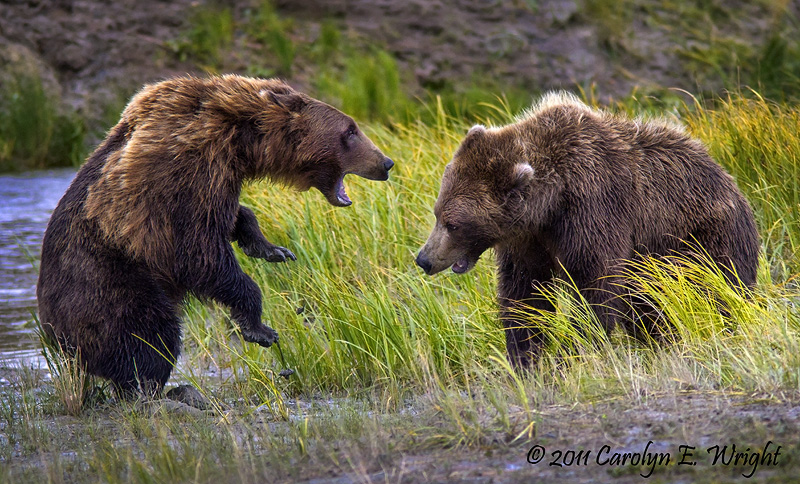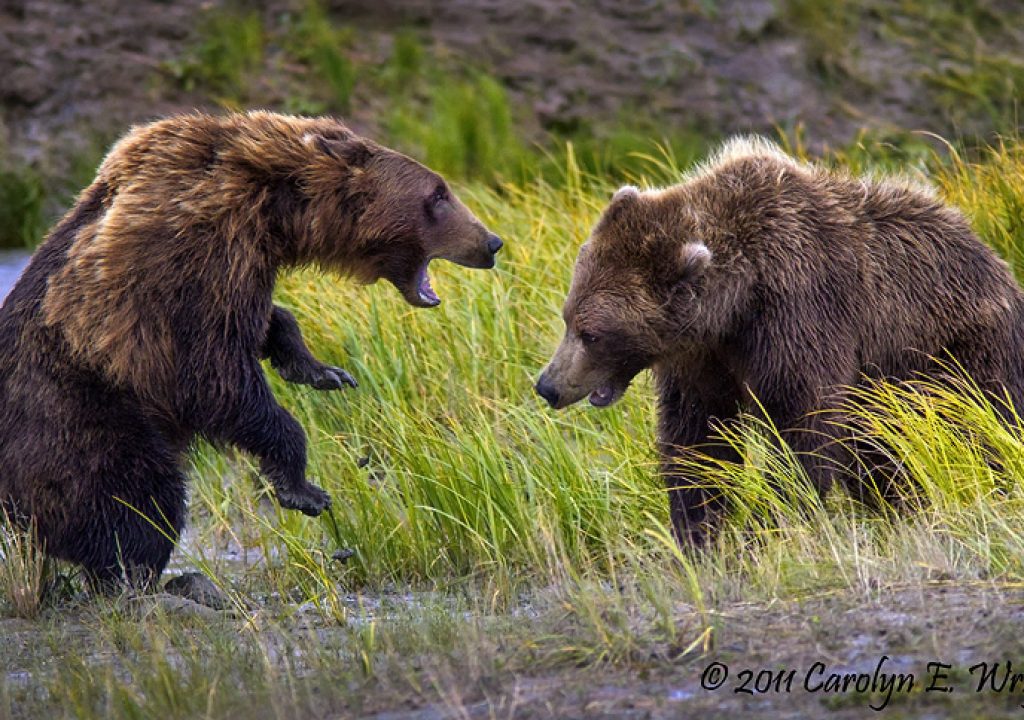
The wildlife shots in this article demonstrate how to include a watermark/CMI
The digital world has given photographers many advantages and disadvantages. We don't have to change film after 36 exposures, use harmful chemicals to process prints, or provide our original negatives for others to reproduce our photos. We also can more easily show our photos via the Internet. But, unfortunately, because it's much easier for others to copy our images, they do. In droves. And it's not just the amateur blogger who is using our photos without permission. Astonishingly, many renowned companies use our photographs to enhance their web page or even to directly make money.
What can you do about this? You could never share your photos with anyone. But that defeats the purpose and goals for many photographers. Instead, listed below are some things that you can do to try to prevent someone from infringing your photos and some remedies if they do, despite your best efforts.
Prevention
Here are some things that you can do to try to stop someone from infringing your photos.
1. Educate others about copyright infringement and respect the copyrights of others.
Many people think that if they aren't trying to make money from the use of a photo then it's not an infringement to copy, display, or distribute it. Help your friends, family, and others to learn about what is copyright infringement. Also, practice what you preach. Don't make illegal copies of music or movies and encourage others not to do so.
2. Make it more difficult for others to use your photos without your permission.
Even though a burglar can break into your home, you still lock your door and set the alarm. Do the same to protect your images. First, disable “right-click” so that novices cannot easily copy and save your images. Second, read the terms and conditions of any website where you may post your images or contest that you enter to make sure that you're not giving up rights to which you're not aware.
3. Put your copyright notice on and/or adjacent to each of your images.
When you post your copyright notice with your photos, it may stop someone from stealing your images, either because it serves as a reminder that the work is protected or because the notice interferes with the use of the work when it is part of the photo. When you post a copyright notice along with your registered images, then the infringer cannot claim that the infringement was innocent (potentially reducing the damages to as low as $200 per work) and the court is more likely to find that the infringement was willful, supporting the maximum in infringement damages.
The official copyright notice has three parts: the first part is the © (the letter “c” in a circle), the word “Copyright,” or its abbreviation, “Copr.” The second part notes the year when the work was first published. The third required part of a copyright notice is the name of the copyright owner. The final form looks like this: © 2013 Carolyn E. Wright. You may use the copyright notice without registering your images with the U.S. Copyright Office. Including a copyright notice is no longer required for copyright protection, but it is a good idea to use it.
4. Put your copyright management information in, on and/or adjacent to each of your images.
Copyright management information (“CMI”) “means any of the following information conveyed in connection with copies of a work or displays of a work, including in digital form (such as in the metadata of your photo file):
- The title and other information identifying the work, including the information set forth on a notice of copyright.
- The name of, and other identifying information about, the author [photographer] of a work or
- The name of, and other identifying information about, the copyright owner of the work, including the information set forth in a notice of copyright.
Section 1202 of the U.S. Copyright Act makes it illegal for someone to remove your CMI from your photo to hide the infringement. The fines start at $2,500 and go to $25,000 in addition to attorneys' fees and any damages for the infringement. You don't have to register your photo in advance to recover under this statute. So, if possible, put your CMI as a watermark on your photo and in the metadata of your digital file (be careful that your CMI is not removed when using a “save for web” function).
5. Register the copyrights to your photos.
When a photo is not registered with the U.S. Copyright Office prior to the infringement (or within three months of the first publication of the photo), a copyright owner may recover only “actual damages” for the infringement (pursuant to 17 U.S.C. 504 (b)), instead of statutory damages. Courts usually calculate actual damages based on your normal license fees and/or industry standard licensing fees. You also may recover the profits the infringer made from the infringement if they aren’t too speculative. Unfortunately, actual damages often don't amount to much so that attorneys will not take your infringement case on a contingency basis.
If your photo is timely registered for an infringement, you will be eligible for statutory damages of up to $150,000 for a willful infringing use. See 17 USC §504(b) and (c). You also may be able to recover your legal fees and costs from the infringer. See 17 USC §505. Additionally, you need to have received your registration certificate to file a complaint for a copyright infringement lawsuit in most jurisdictions.
Check my article for instructions on how to register your photos with the U.S. Copyright Office: http://www.naturescapes.net/docs/index.php/articles/341.
Remedies
When you are infringed (and the odds are high that you will be if you make your photos available to others), you must decide what to do about it. Here are some options:
1. Prepare and send a DMCA Take-Down Notice. Thanks to the U.S. Digital Millennium Copyright Act (“DMCA”) enacted in 1998, the Internet Service Provider (“ISP”) that hosts a website is not liable for transmitting information that infringes a copyright only if the ISP removes the infringing materials from a user’s website after receiving proper notice of the violation. The notice must: be in writing, be signed by the copyright owner or the owner’s agent, identify the copyrighted work claimed to be infringed (or list of infringements from the same site) and identify the material that is infringing the work.
Additionally, the notice must include the complaining party’s contact information, a statement that the complaint is made in “good faith,” and a statement, under penalty of perjury, that the information contained in the notification is accurate and that the complainer has the right to proceed (because he is the copyright owner or agent). Check my article here: http://www.naturescapes.net/docs/index.php/articles/314 to learn more about how to prepare a DMCA take-down notice. Even if you don’t reside in the U.S., you may use this great tool to stop an infringer whose ISP is in the U.S. from using your work.
2. Prepare and send a “cease and desist/demand letter yourself.
When you don't want to alienate the infringer (the infringer is a potential client and/or appears to be an innocent infringer), you may want to contact the infringer to explain that the use is not authorized and either request payment of an appropriate license fee, a photo credit with a link to your website, or that the infringer cease use of the image. It’s best to do this in writing – a letter by surface mail seems to have more clout than email correspondence. There are some risks in sending the letter yourself. First, the infringer may attempt to preempt an infringement lawsuit and file a request for declaratory judgment that the use is authorized. This may involve you in a legal action for which you may need legal counsel in a jurisdiction (court location) where you don’t want to litigate. Second, your demand for payment may be admissible against you if an infringement case is filed. If you demand too little, then it may limit your ultimate recovery. To avoid this possibility, include in your demand letter that “these discussions and offer to settle are an attempt to compromise this dispute.” A form Cease & Desist Letter for copyright infringement of a photo is available here: http://www.photoattorney.com/products/
3. Hire a lawyer to send a demand letter.
When an attorney gets involved, the matter is escalated and tensions rise. While the infringer may be more defensive, the weight of your demand letter is dramatically increased if it comes from an attorney and the infringer generally takes the matter more seriously. Some attorneys charge a flat fee to send a letter, others may charge a “contingency fee” which is based on the percentage of recovery, or the attorney's fee may be a combination of both.
4. File a lawsuit.
Your most aggressive option is to pursue your legal remedies by filing suit. Unless you have a breach of contract or some other state claim, you must file your infringement claim in a federal district court (http://www.uscourts.gov/districtcourts.html). To file suit, it is best to hire an attorney to help you because the legal procedures are complicated. Note that you have three years from the date of infringement to sue for copyright infringement.
Conclusion
Infringements are rampant these days, both because it’s easier for the infringers to copy your images and because too many people think that they have a right to use your photos or they won’t be caught. Fortunately, there are many ways to prevent and remedy copyright infringement.
_____________________________
Carolyn E. Wright is a licensed attorney dedicated to the legal needs for photographers. Get the latest in legal information at Carolyn’s website, www.photoattorney.com. These and other legal tips for photographers are available in Carolyn’s book, The Photographer’s Legal Guide, available on her website.
NOTE: The information provided here is for educational purposes only. If you have legal concerns or need legal advice, be sure to consult with an attorney.
Copyright Carolyn E. Wright, Esq.
www.photoattorney.com
All Rights Reserved

